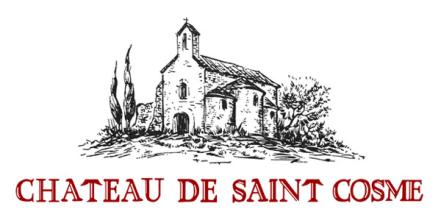Château de Saint Cosme
Le Poste
Château de Saint Cosme
Le Poste
Château de Saint Cosme is the leading estate of Gigondas and produces the benchmark wines of the appellation. The property has been in the hands of the Barruol family since 1490. Louis Barruol took over from his father in 1992 making a dramatic shift to quality and converting to biodynamics in 2010.
Château de Saint Cosme Côtes-du-Rhône Blanc Le Poste is from a 1-hectare terraced vineyard that sits near the chapel of Saint Cosme, a short uphill climb from the winery. The maximum elevation is 280 meters, 140 meters above the Gigondas valley floor, and is one of the coolest vineyards in Gigondas. The terraces and elevation make it necessary to plow the vineyard by horse.
The vineyard was replanted in 1963 by Henri Barruol to a field blend based mainly on Grenache and one small parcel of Clairette from which Le Poste Blanc is produced. This 100% Clairette was vinified in used traditional demi-muids without malolactic fermentation and aged 10 months on lees.
Tasting Notes
Clairette is an old variety that likely originated in southern France often used to produce simple and crisp dry white wines or as a component in a blend such as Châteauneuf-du-Pape blanc. White wines from Clairette have a tradition at Saint Cosme, specifically at Le Poste, where Louis Barroul’s grandfather produced famously long-lived Le Poste Blanc. Limestone soils give Le Poste Blanc a flavor of gunflint and the ability to age for twenty years or more.
Food Pairing
When Clairette is made in a serious manner it deserves the same place at the table as great white burgundy, especially when from an outstanding vineyard such as Le Poste. In fact, Le Poste Blanc can be used at the table much in the same way a great Chablis might pair well with oysters, roast chicken, or rabbit in mustard sauce.
Château de Saint Cosme is the leading estate of Gigondas and produces the benchmark wines of the appellation. The property has been in the hands of the Barruol family since 1490. Louis Barruol took over from his father in 1992 making a dramatic shift to quality and converting to biodynamics in 2010.
Château de Saint Cosme Côtes-du-Rhône Blanc Le Poste is from a 1-hectare terraced vineyard that sits near the chapel of Saint Cosme, a short uphill climb from the winery. The maximum elevation is 280 meters, 140 meters above the Gigondas valley floor, and is one of the coolest vineyards in Gigondas. The terraces and elevation make it necessary to plow the vineyard by horse.
The vineyard was replanted in 1963 by Henri Barruol to a field blend based mainly on Grenache and one small parcel of Clairette from which Le Poste Blanc is produced. This 100% Clairette was vinified in used traditional demi-muids without malolactic fermentation and aged 10 months on lees.
Tasting Notes
Clairette is an old variety that likely originated in southern France often used to produce simple and crisp dry white wines or as a component in a blend such as Châteauneuf-du-Pape blanc. White wines from Clairette have a tradition at Saint Cosme, specifically at Le Poste, where Louis Barroul’s grandfather produced famously long-lived Le Poste Blanc. Limestone soils give Le Poste Blanc a flavor of gunflint and the ability to age for twenty years or more.
Food Pairing
When Clairette is made in a serious manner it deserves the same place at the table as great white burgundy, especially when from an outstanding vineyard such as Le Poste. In fact, Le Poste Blanc can be used at the table much in the same way a great Chablis might pair well with oysters, roast chicken, or rabbit in mustard sauce.













